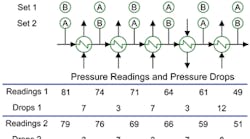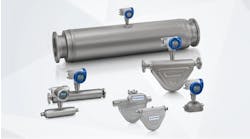[pullquote]Occasionally I teach a seminar on troubleshooting. Attendees may include plant engineers or operators. At one such recent event, a participant commented the discussion was too simple and the points made were “just common sense.” I didn’t argue. However, a modified version of the well-known statement of Carl von Clausewitz in “On War” certainly applies: Everything is very simple in troubleshooting, but the simplest thing is difficult.
So let’s look at a simple thing — taking pressure measurements — to see how to do it right.
Let’s say we’re looking for possible fouling or plugging problems in a heat exchanger train. Troubleshooting here involves using gauges to take pressures at various points in the preheat train. Subtracting one reading from another gives the pressure drop between the two points on the train. Three technical constraints limit useful data from pressure gauges in determining accurate pressure drops.
[callToAction ]
1. Pressure changes caused by factors other than fouling or plugging during the measurement. Examples of such factors include modifications to pump operation, static head or flow rate.
2. Accuracy in measurements. Both bias (offset in readings) and random error will influence the usefulness of the results.
3. Accuracy required to get a useful value where a small number is generated by subtracting two large numbers. This makes accuracy errors much more difficult to handle.
We could use a single gauge and move it to take all the readings. Relying on the same gauge helps reduce or eliminate the effect of bias on the readings. However, moving the gauge takes time. Moreover, it’s difficult to determine outside factors that might affect the next reading.
Instead, we could use two gauges — installing them at adjacent measurement points and then taking readings at the same time. The difference between the readings indicates the differential pressure between the two points.
However, this measurement suffers from bias. The pressures labeled Set 1 in Figure 1 show the result of bias. Gauge A always reads too high and Gauge B always too low. So, the differential pressures calculated show a seesaw deviation. The first calculation is too high — this is the result of a too-high reading minus a too-low reading. The second is too low — the result of a too-low reading minus a too-high one.
How can we make our pressure readings better?
One way is to take a second set of readings. Switch the gauges and start over. Set 2 in Figure 1 shows these readings. This time we end up with the same seesaw of inaccuracy but in the opposite directions from the first set. Averaging the pressure drops from both sets of data (the lower line in Figure 1) eliminates the bias of both gauges. In this case, the last heat exchanger on the right has twice the average pressure drop of the other exchangers!
Figure 1. Using two pressure gauges and taking two sets of data can provide results that minimize the effect of each gauge’s bias.
Of course, this approach has its own assumptions. The biggest one is that the bias on each gauge remains constant. So, I highly recommend adding a step to the procedure: Put both gauges on the same point and compare them. At a minimum, do this at the start of the first survey, when you begin the second survey with switched gauges, and when the survey is finished. For every reading, record the gauge used as well as the pressure. Clearly label the gauges!
This technique helps decrease the effect of bias when gathering plant data. It doesn’t address random errors in readings — future columns will look at techniques to reduce the consequences of random errors on pressure readings to calculate differential pressures across equipment.
Yes, taking pressure readings is simple, but the simplest thing can be difficult!



